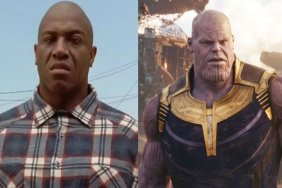With all the hubbub about DC’s Forever Evil, Villains Month and editorial practices, we almost missed the second entry in Marvel’s event book Infinity. The Avengers are in space, teaming up with an intergalactic force trying to fend off the rogue Builders, and it’s going badly. Meanwhile, Thanos and his Cull Obsidian (who would prefer to be called the Black Order, but Thanos doesn’t really accommodate the preferences of others) are making their move on Earth and confronting Attilan.
Thanos has a massive armada invading Earth. Corvus Glaive and Supergiant of the Black Order have subdued the X-Men, while Proxima Midnight has subjugated Atlantis and The Ebony Maw has bewitched Dr. Strange. Wakanda, ever the nation of badassery, fended off The Black Dwarf and his hordes, but given that Namor sold them out to Proxima, they might not hold for much longer when the Black Order consolidates their forces. Their first order of business, however, is sending Corvus to King Black Bolt of the Inhumans to demand a tribute in death – the heads of every Inhuman between the ages of 16 and 22 – or else they will be destroyed.
Cut to the Avengers in space. Having just lost a massive battle to the Builders, the Imperial Guard has joined the fight personally, and they manage to launch an actual surprise attack, destroying some Builders and scoring their first victory – but it’s to be a bitter one. Even in defeat, one of the “Ex Nihili” – aka Gardeners – drops down to a peaceful farming community and kills himself, decaying and murdering the entire planet in the process.
In the day they have to decide whether or not to accept The Black Order’s demands, Black Bolt calls a meeting of the Illuminati in a special pocket reality where he can verbally speak without murdering everyone. In it, he offers secret histories of the Inhuman royal lineage, and reveals that Thanos doesn’t really care about all the deaths he’s demanding – he’s just trying to make sure that one specific Inhuman is dead, one who happens to be Thanos’ son.
Perhaps the best compliment I can give Infinity so far is that it doesn’t feel like an event book – it feels like a story. It doesn’t seem like a misguided, out-of-character hodge-podge of “wouldn’t it be cool if-” action sequences designed solely to seem “cool” and plug future books. It feels like Jonathan Hickman is actually going somewhere with this, and cares about how we get there. It’s certainly dark and heavy, but that moment where the Avengers are witnessing the Builders’ dedication to destruction (the opposite of what they are supposed to be about) is a powerful one. “Hundreds of thousands of refugees watched as the ones left behind became seething vessels of death and disease. This was worse than death. It was our first victory.”
Jerome Opeña’s artwork is always stellar. Grandiose and epic when it needs to be, gruesome and ominous when the story demands it, the man does amazing, moody things that fit Hickman’s style perfectly. The moment where Corvus nullifies Medusa’s threats of death to those who would demand things of Attilan by having all of his soldiers slit their own throats is a disturbing, ugly moment that gives us a greater understanding of the Black Order – and there’s a moment of dark humor when Corvus explains they prefer “Black Order” to “Cull Obsidian” (aka Midnight Slaughter) because it’s “less foreboding.”
The stakes are very high in Infinity, as is the body count so far. We often complain about character death used as a shock tactic to try to make event books seem more important, but our faith in Hickman is strong enough that if he goes that way and kills someone we actually know, this story is thick enough with intrigue and legitimately-crafted cosmic menace that it will feel earned instead of forced.





